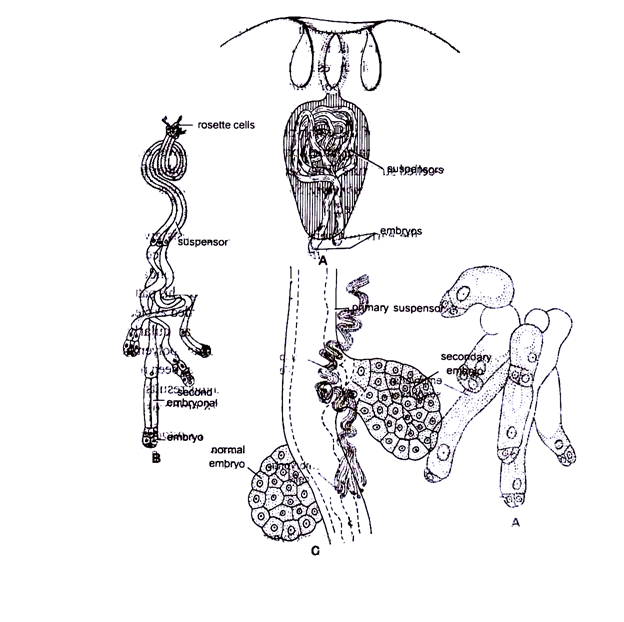Polyembryony is the phenomenon of the development of more than one embryo in one ovule, seed or fertilized ovum. This usually seen in both animals as well as plants. Most striking situations of polyembryony are being detected in certain animals e.g. parasitic Hymenoptera, where up to 2,000 embryos can spring from one zygote. this incident was first reported by a man called Antoni van Leeuwenhoek 1719 in orange seeds as a plant. In several gymnosperms, the polyembryony is very common that it might be regarded as an important character of this group. The majority of the gymnosperms showing polyembryony, usually two or more archegonia establish in a female gametophyte. And as each of archegonium contains an egg, two or more eggs may fertilize and thus two or more potential embryos may be created. Only one embryo, however, usually survives, and all the others perish during the course of the development. Polyembryony is suggested to be having two types and they are:
- Induced Polyembryony: This includes the cases of experimentally induced polyembryony.
- Spontaneous Polyembryony: This is all cases of naturally occurring polyembryony.
A man called Webber 1940 was able to classify polyembryony into following three types :
- Cleavage Polyembryony: This where a single fertilized egg gives rise to a number of embryos.
- Simple Polyembryony: This is where a number of embryos develop as a result of the fertilization of several archegonia.
- Rosette Polyembryony: In this type some gymnosperms e.g. a few species of Pinus, additional embryos develop from the rosette cells, and this type of polyembryony has been termed as rosette polyembryony.
Polyembryony can be seen in Cycadales but is not a common occurrence according to Rao in 1964, however, reported simple polyembryony in Cycas Circinalis. Two adjacent archegonia of the same ovule in this species sometimes develop freedom into two embryos and also rarely into two seedlings. Polyembryony has also been reported in Cycas rumphii by a man called De Silva and Tambiah 1952. Only one out of the several embryos, however, remains potential and persists in this species.

And ever since it has been discovered by researchers or scholars that Polyembryony can also be seen in Coniferales, Taxales, Gnetales. These are various groups of Gymnosperms which Polyembryony usually occur, those other scholars or researchers have discovered new but not well established which made them be irrelevant.